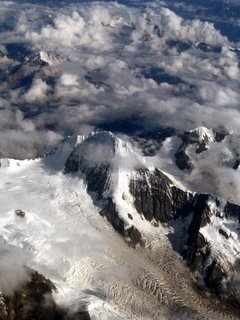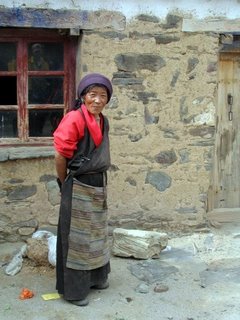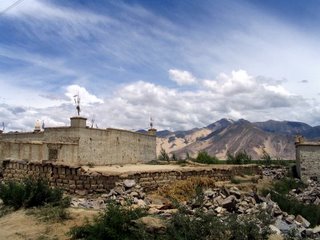 are still not able to buy tickets to Tibet themselves, they have to go through a travel agency to receive a 'tour permit', which is simply a front for the government to pocket about 300 RMB...but that's the way it is. I had originally wanted to take the new train to Tibet, which started running at the end of July, but the tickets are still very hard to come by. So, plane it was.
are still not able to buy tickets to Tibet themselves, they have to go through a travel agency to receive a 'tour permit', which is simply a front for the government to pocket about 300 RMB...but that's the way it is. I had originally wanted to take the new train to Tibet, which started running at the end of July, but the tickets are still very hard to come by. So, plane it was.I took off on August 3rd at 8:00am, after paying 230 RMB in excess charges for my bike, running around the airport to put the bike through an x-ray machine, and then watching it loaded into the plane from my window seat. The flight was very smooth and only took about two hours. There wasn't much of note besides the fact that I was sitting with approximately 30 other foreigners and oh yeah... the view. Chengdu sits in one of the largest fertile basins in China, a large stretch of land shaped like an oval and surrounded on all sides by mountains and directly to the west of Chengdu, the Himalayas come screaming out of the ground. Flying over Eastern Tibet, the plane skirted over jagged snow capped peaks, which the clouds struggled to rise above. These mountains were ringe
 d with mile long glaciers that ran through the valleys on every side. It seemed as if the plane was just a few feet above the tallest mountain peaks, but the river gorges cutting through the mountains were a dizzying three vertical miles further down. I snapped a dozen or so pictures, but none of them seemed to do the view justice, and then before I knew it, we were already starting to descend.
d with mile long glaciers that ran through the valleys on every side. It seemed as if the plane was just a few feet above the tallest mountain peaks, but the river gorges cutting through the mountains were a dizzying three vertical miles further down. I snapped a dozen or so pictures, but none of them seemed to do the view justice, and then before I knew it, we were already starting to descend.While everyone streamed out of the baggage claim area and started jostling for seats on the next bus or cab into Lhasa, I began putting my bike together. This time, I didn't almost break down into tears (as was not the case back in New Orleans on my first bike trip). I was so excited to get moving, but I took my time getting everything ready, pausing to take deep breaths of the crisp, cool air. Finally, I got on my bike, made my way to the exit of the small Lhasa airport, and took a left onto the only road.
The sky was a deep blue and the mountains on either side of the valley were splashed with sand dunes. Tibet is by all regards, a high
 altitude desert, and the stark contrast between the aridity and shimmering fertile valleys caught me off guard. Soon after leaving the airport, I began passing small farmhouses that were built from mud brick. Each house was built in a courtyard fashion, but the architecture was very different from anything I had seen in China. Each house had a stick on all four corners of the outer wall that was covered in prayer flags. Then, flying high above on a stick located in the center of the roof, a Chinese flag was commonly seen. Which I later found out, is a requirement for certain houses and towns. There were also ornate paintings under the door way and window eves. But the thing that surprised me the most, were the people. As soon as I left the airport and started down the road, I was greeted with smiles and waves. The fact that something as simple as friendliness towards a stranger could catch me so off guard, should tell you a great deal about China. Throughout the day, the friendliness of the local people astounded me time and time again.
altitude desert, and the stark contrast between the aridity and shimmering fertile valleys caught me off guard. Soon after leaving the airport, I began passing small farmhouses that were built from mud brick. Each house was built in a courtyard fashion, but the architecture was very different from anything I had seen in China. Each house had a stick on all four corners of the outer wall that was covered in prayer flags. Then, flying high above on a stick located in the center of the roof, a Chinese flag was commonly seen. Which I later found out, is a requirement for certain houses and towns. There were also ornate paintings under the door way and window eves. But the thing that surprised me the most, were the people. As soon as I left the airport and started down the road, I was greeted with smiles and waves. The fact that something as simple as friendliness towards a stranger could catch me so off guard, should tell you a great deal about China. Throughout the day, the friendliness of the local people astounded me time and time again.One of my first stops was a small Tibetan village and a monastery. This first monastery set the pace for the rest of my trip... which found me not spending any money on entrance fees into the larger monasteries, which can sometimes cost 50 kuai or more (which was typically my budget for an entire day). So, I walked around the small Tibetan town and then we
 nt to explore the hillside ruins of a large monastery that was dynamited during the Cultural Revolution. Trudging up the hillside took a little while, but the view of the valley below and having a whole complex of thousand year old ruins to explore by myself, was just what I had been looking for. After spending about two hours in the ruins I watched thunderclouds slowly work their way into the valley a few miles away and decided it was time to eat and then find a place to sleep.
nt to explore the hillside ruins of a large monastery that was dynamited during the Cultural Revolution. Trudging up the hillside took a little while, but the view of the valley below and having a whole complex of thousand year old ruins to explore by myself, was just what I had been looking for. After spending about two hours in the ruins I watched thunderclouds slowly work their way into the valley a few miles away and decided it was time to eat and then find a place to sleep.I quickly glanced around and then pulled off the road. The spot I found to camp was about 400 meters from the road in an orchard, a really beautiful place. I set up my tent, which must now be set up with the aid of a stick, and I sat outside to write. The fact that a person can waste a day getting up at 12:00, only
 to go shopping and watch a movie, as I have done today while writing this on the computer, or, a person can spend that same day flying into Tibet, biking 60 miles, exploring and experiencing new sites, food, and people, and then spending the night in the middle of the Tibetan countryside, boggles my mind. The day had been fantastic. On my first day I saw a place and a people that were truly different. While I watched the same orange and blue dump trucks fly past, saw much of the same cement Chinese architecture, and saw hundreds of signs in Chinese, the differences between this place and China stand out just as clearly as those signs welcoming you to this county or that in Chinese script. The sheer friendliness of the people, the language, the architecture, the dress, the food, the breath-taking surroundings, and some undercurrent that may simply be owed to the aura surrounding Tibet, manages to clearly set this place apart from China.
to go shopping and watch a movie, as I have done today while writing this on the computer, or, a person can spend that same day flying into Tibet, biking 60 miles, exploring and experiencing new sites, food, and people, and then spending the night in the middle of the Tibetan countryside, boggles my mind. The day had been fantastic. On my first day I saw a place and a people that were truly different. While I watched the same orange and blue dump trucks fly past, saw much of the same cement Chinese architecture, and saw hundreds of signs in Chinese, the differences between this place and China stand out just as clearly as those signs welcoming you to this county or that in Chinese script. The sheer friendliness of the people, the language, the architecture, the dress, the food, the breath-taking surroundings, and some undercurrent that may simply be owed to the aura surrounding Tibet, manages to clearly set this place apart from China.On the next day I would rise and head to Samye monastery, the first in Tibet. It required a boat ride, which was a bit of nerve-racking because of the fact that anyone (foreigners) in this valley is supposed to have a permit for traveling and the police supposedly use the Samye ferry as a standard spot for checking permits.

2 comments:
It's is ironic that the only way I know I am wasting my day in front of a computer while other people explore Tibet is to sit in front of a computer.
btw your pictures are awesome.
Post a Comment